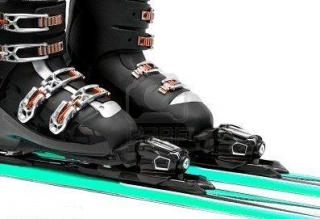Once on the ski slopes, don’t be intimidated by steep gradients or fearless skiers with fluid, confident movements... one day, you’ll be one of them!

Choosing the Terrain
The most important aspect of a ski course, at any level, is the terrain where you practice your technique. A poor choice could hinder your progress. Note that the technical difficulty of a slope is indicated by the colour of the poles marking its route.

The colours, in order of difficulty, are green, blue, red, and black, and are marked on the piste maps of each ski resort. The beginners’ area is usually on the flatter section, where the lifts for green and blue slopes start.
The ideal terrain for a beginner should be flat with soft snow, to prevent skis from slipping and to ensure greater stability.

Getting Used to the Equipment
Ensure the ski boot clips are fastened correctly—tight enough to prevent foot movement but not so tight they cause discomfort. It’s crucial that your ankles don’t shift, so your shins should remain firmly pressed against the boot’s upper section.

To put on your skis in the snow, place them parallel and perpendicular to the natural slope (if there is one). Next, slide your boot into the binding, checking no snow is stuck to the sole. Start with the downhill ski (the lower one) followed by the uphill ski.
When you press the bindings, the safety locks engage, and the ski soles grip the snow perfectly. Now, the feeling is different—you’re one with your new mode of transport, ready to begin your first adaptation exercises.

The natural stance for skiing is as follows:
- The distance between skis should match the width of your hips.
- Keep ankles and knees slightly flexed forward.
- Arms should also be slightly bent and away from the body. At this beginner stage, ski poles mainly serve as support aids on the snow, making movement easier.
- Lift the ski’s heel section.
- Raise the entire ski base using the ball of your foot.
- Once lifted, cross the ski tip over the other ski’s tip without touching; rotating your foot inward turns the ski.
- After lifting the ski fully, cross its tail over the other ski’s tail without contact; opening your foot outward spreads the ski’s tail.
Why do this?
To realise that skis act like giant feet—so avoid abrupt movements that lose control. Excessive spreading or uncontrolled turns can lock your skis.
More Exercises:
- Knee bends.
- Rotations on your axis, e.g., looking behind you.
- Small jumps (carefully!).

Moving Adaptation Exercises
- Walk normally, as you would on a street, lifting one ski at a time and alternating pole support.
- Practice circles. Control the skis’ spreading carefully—if circling right, avoid over-opening the right tip, or the skis’ tails may lock. Use short movements to prevent skis crossing.
- Repeat circles in both directions.
- Gliding. This is your first experience of moving as one unit with your skis. Remember the natural stance: skis parallel, hip-width apart, ankles/knees flexed forward. Lean your torso forward as you push with both poles. Don’t lean back—let the glide carry you. Maintain steady speed and balance.













